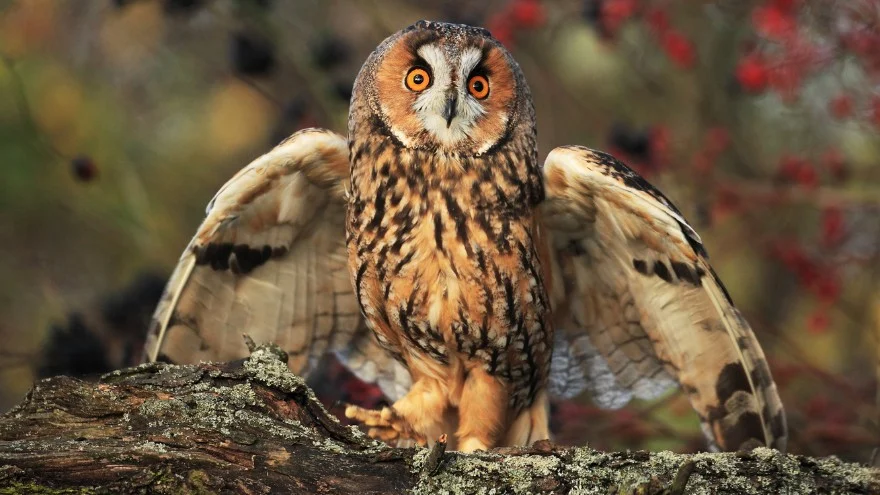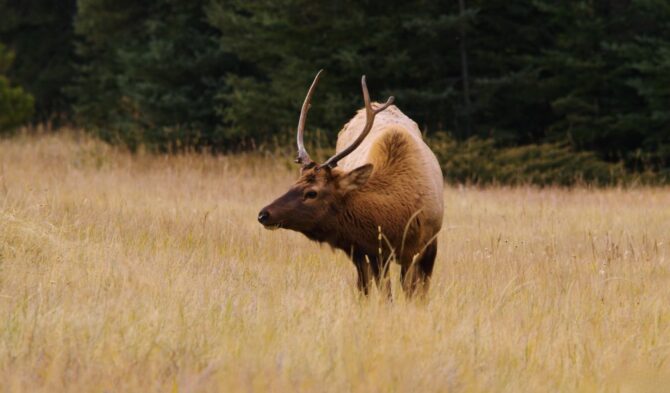Michigan is located in the upper Midwestern parts of the United States, large and well-populated. It is considered the 10th largest state by population and the 11th by area.
Amidst the population, different animals inhabit Michigan. They include owls, which we’ll be looking into in this article.
There are eleven species of owls in Michigan, including the spotted owl, great horned owl, barn owl, and long-eared owl, among others.
Some are easier to find than others, but generally, you need to carefully observe as owls tend to be shy and elusive.
Read on to discover interesting details of all these nocturnal birds, including facts on how to recognize the different species based on their appearance, sounds, and migratory patterns.
The 11 Species of Owls in Michigan
1. Great Horned Owl

- Scientific name: Bubo virginianus
- Length: 18 to 25 inches
- Weight: 32 to 88 pounds
- Wingspan: 40 to 57 inches
The great horned owl is a native of the Americas, and it is the most widespread true owl in this region. It is also called the tiger owl or the hoot owl.
These birds can be found in Michigan all year because they hardly migrate and often settle in whatever territories they find themselves in.
It can adapt to different habitats and often nest in tree holes, burrows, or animal dens.
This creature is colored a greyish brown at the top, and the underpart is light. It also has brown barrings and a visible white patch on the throat.
In Michigan, you might find owls around animal dens, tree holes, parks, and some suburban areas.
Birds of this species hoot, but they aren’t limited to the conventional owl sound. They have an array of calls, from screeches to growls and mews. Some of them can be downright scary.
The great horned owl is majorly nocturnal, but you can find it during the day on some occasions.
It is a strong hunter, feeding on a variety of prey. Its diet includes fish, amphibians, invertebrates, and reptiles. Sometimes, they may even eat carrion.
2. Long-eared Owl

- Scientific name: Asio otus
- Length: 14 to 16 inches
- Weight: 8 to 15 pounds
- Wingspan: 35 to 39 inches
The long-eared owl is recognizable for its long ear tufts. It falls under the genus Asio, and all the birds in the group have feather tufts on the head that seem like ears. It also goes by the name northern long-eared owl, cat owl, or lesser horned owl.
Its plumage is dark with different patterns, a combination of grey, brown, and buff. The underparts have dark brown streaks as well. It is slim in weight and boasts broad wings.
In Michigan, the long-eared owl dwells a lot in the northern parts of the state. However, you can also find it in central and south Michigan. It dwells in a lot of habitats, including farmlands, orchards, gardens, cemeteries, and parks.
This owl is shy and elusive, making it quite hard to spot. You have a better chance of hearing it. The male’s call sounds like a song, while the female has a whistle.
Its diet is more limited than that of the great horned owl, as it often targets rodents. However, it can also feed on insects and birds. It generally doesn’t build its own nest but resides in that of other animals.
3. Short-eared Owl
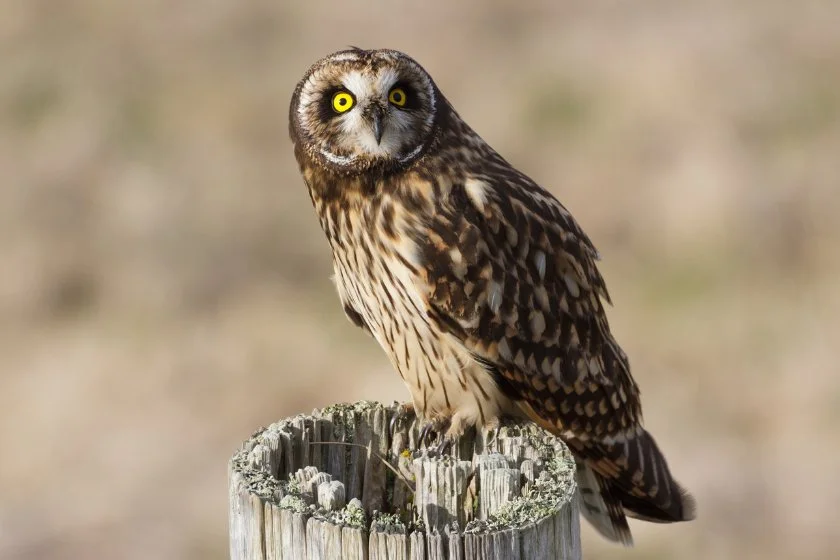
- Scientific name: Asio flammeus
- Length: 14 to 17 inches
- Weight: 7 to 17 pounds
- Wingspan: 34 to 41 inches
The short-eared owl is a relative of the long-eared owl, and they both belong to the same genus. Their names show the major difference between them.
The short-eared owl has shorter ear tufts, contrary to its relative. Preferred habitat includes open country and grasslands. It builds its nest and is often found in the north of Michigan during the breeding season.
The species is medium-sized with a round head and a small feather tuft. On the upper parts of its plumage, it is colored brown, buff, and white. The lower part is colored buff with dark streaks on the breast.
The nest is often built on the ground with low vegetation. While it occurs more in the North during the breeding season, you’d often find the birds in other parts of Michigan during winter.
The bird often hunts at night, but there’s no absolute rule. It can be either diurnal or crepuscular.
Its preferred prey is the vole, and it seemed to have adapted to the lifestyle of the little mammal. It can also feed on smaller animals like rabbits, mice, rats, shrews, and muskrats.
4. Northern saw-whet Owl
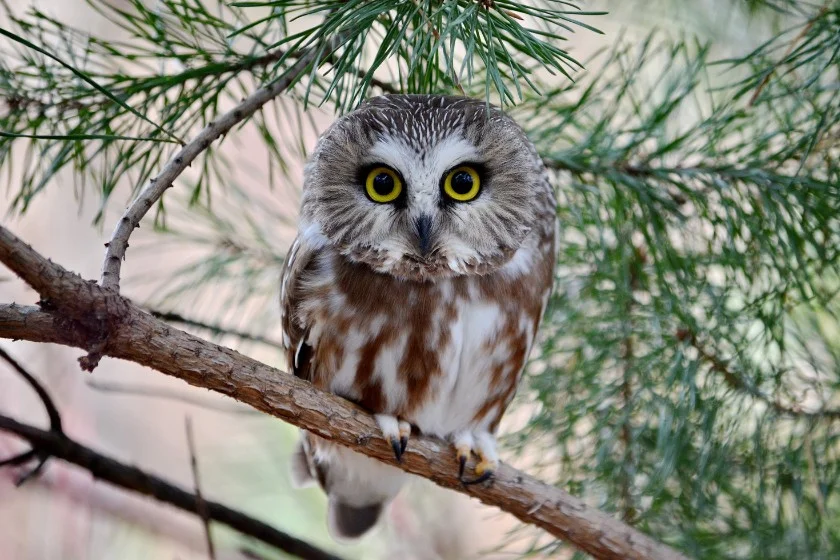
- Scientific name: Aegolius acadius
- Length: 7 to 9 inches
- Weight: 2 to 5 pounds
- Wingspan: 17 to 22 inches
The northern saw-whet owl derives its name from the sound it makes, usually described by others as being like a saw sharpened on a whetstone. This sound is often used during mating season to find the appropriate mate.
The saw-whet owl is a very small species that are native to North America. It can be found all year in Michigan, where it lives in coniferous forests.1
It feeds mainly on rodents which it hunts at night. Other prey includes insects, birds, bats, and amphibians.
This bird is known to have a large head that’s round. It also comes with a brown plumage with white spots on the upper part and white streaks at the lower parts.
The face is a pale brown, the eyes are yellow, and it has a compact body.
5. Barn Owl
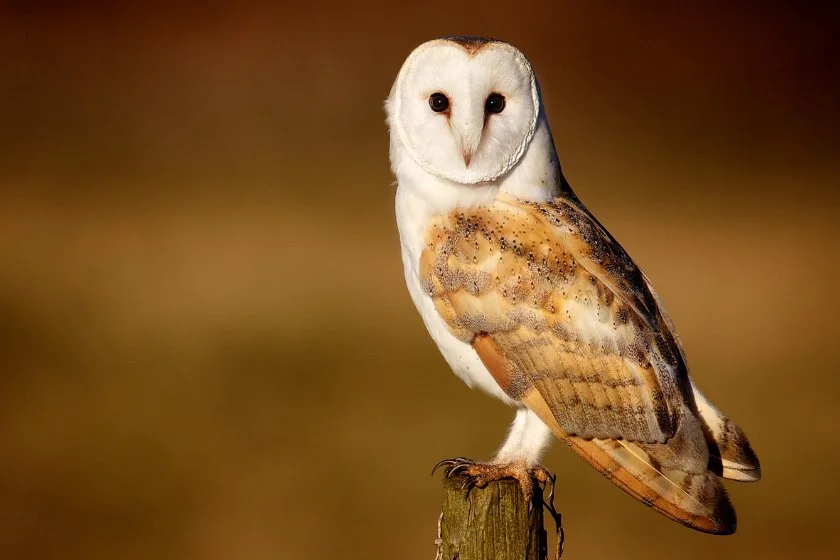
- Scientific name: Tyto Alba
- Length: 13 to 16 inches
- Weight: 14 to 25 pounds
- Wingspan: 40 to 50 inches
The barn owl was given the name due to its living arrangements. It inhabits barns and abandoned buildings.
This species is the most widespread owl and can easily be seen around the human residence. Though feared, this owl is just as harmless as others.
Not everyone fears it, of course. Some would call it a beauty, and it is. The barn owl is medium-sized with a face shaped like a heart.
The upper parts of its body are covered with rusty brown feathers, while the lower side is either cream or white. Ditto for the face. It completes its physical features with a slender leg and broad wings.
In Michigan, the best place to see barn owls is in the south. They come out only at night, and you’re likely to sight them flying low as they search for prey. They go after voles, rodents, insects, amphibians, bats, and lizards.
6. Snowy Owl
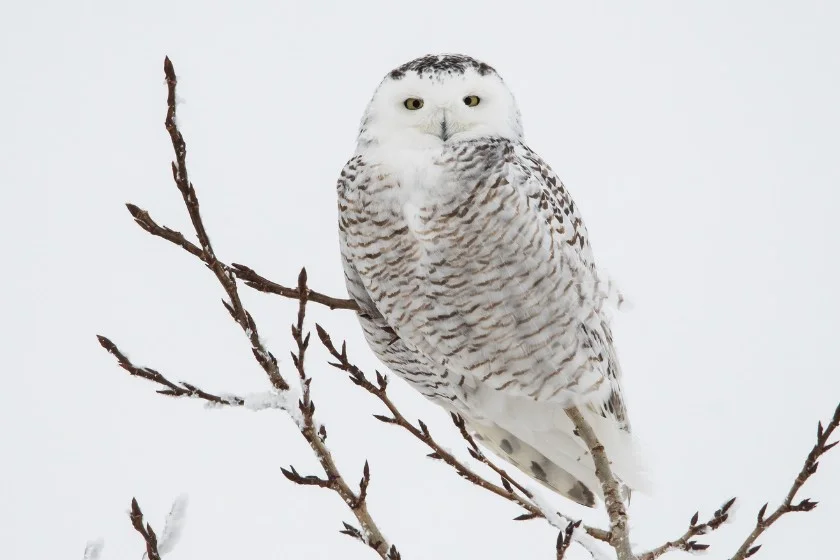
- Scientific name: Bubo scandiacus
- Length: 21 to 28 inches
- Weight: 56 to 104 pounds
- Wingspan: 50 to 57 inches
The snowy owl is also called the artic owl, the white owl, and the polar owl. It is one of the most striking species due to its luscious white plumage, and it’s hard to miss it if you see it.
That said, it is rare in many US states because it lives more in the arctic regions. The only time you might get a chance to see these birds is during winter when they migrate.
Snowy owls are nomadic and would sometimes get to the south of Michigan. In the state, you’d find them in meadows, prairies, grasslands, lakeshores, and coastal habitats.
Males are often whiter than females, though it is rare to see an individual that’s completely white. Females have more spots and bars. Both genders have small heads, short ear tufts, and long feathers.
Besides their color and nomadic nature, another unique quality of snowy owls is their ability to hunt both during the day and at night.
They also rely on their sight more than other senses to hunt. They feed on fish, birds, and rodents.
7. Great Gray Owl
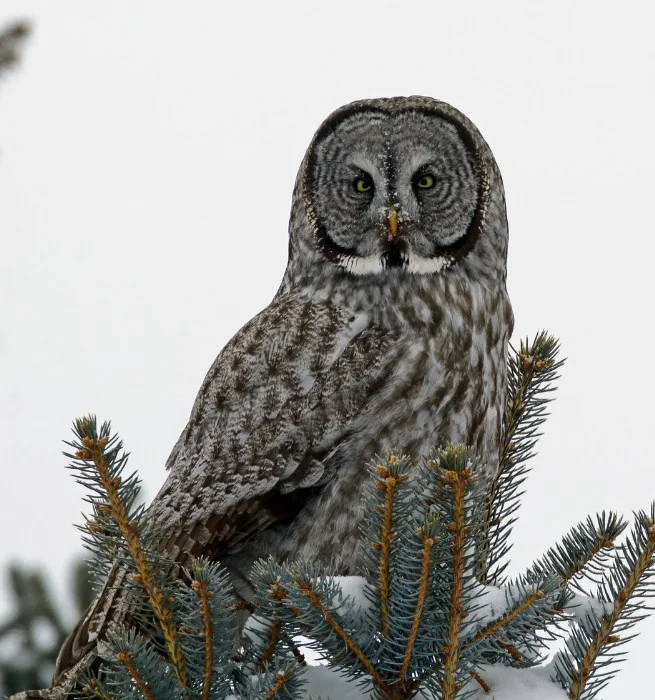
- Scientific name: Strix nebulosa
- Length: 24 to 33 inches
- Weight: 25 to 60 pounds
- Wingspan: 54 to 60 inches
The great gray owl is a very large and unique-looking bird. It goes by a host of other names like Phantom of the North, spectral owl, spruce owl, sooty owl, Lapland owl, and bearded owl.
It is somewhat rare in Michigan but can be seen in some areas, like the far north of the Upper Peninsula. It inhabits dense forests and mixed woodlands where it breeds.
This bird is termed unusual, and not just because of its size—though the size makes it stand out.
The great gray owl is colored gray at the upper parts of its body, and its got dark streaks underneath. It has a big head, gray face, and yellow eyes.
The great gray owl makes a variety of sounds, and this can help you easily locate it. The common call is deep and sounds like whoo to human hearing. It can also hiss and chatter.
This bird doesn’t build a nest but rather stays in the abandoned nests of other birds. Like other owls, it is carnivorous.
It feeds almost exclusively on rodents and depends a lot on its hearing to locate prey.
8. Eastern Screech Owl

- Scientific name: Megascops asio
- Length: 6 to 10 inches
- Weight: 4 to 9 pounds
- Wingspan: 19 to 24 inches
The eastern screech is often found in the eastern parts of North America, hence the name. It is especially located in Canada and Mexico.
Eastern screech owls in Michigan are a common sight and can be found all year. Unlike some other owl species, the eastern screech is accustomed to humans and lives around residences.
There are two color morphs of the eastern screech, gray and rusty brown. You are more likely to find the gray-colored variant in Michigan.
All other features are identical. The eastern screech has a large head with ear tufts, yellow eyes, and yellow bills.
These creatures are nocturnal, often hunting after sunset. Their preferred diet depends a lot on the season in question.
During the breeding period, they feed on insects, spiders, and other invertebrates. When winter comes, they go after small mammals and birds like mice and voles.
9. Barred Owl
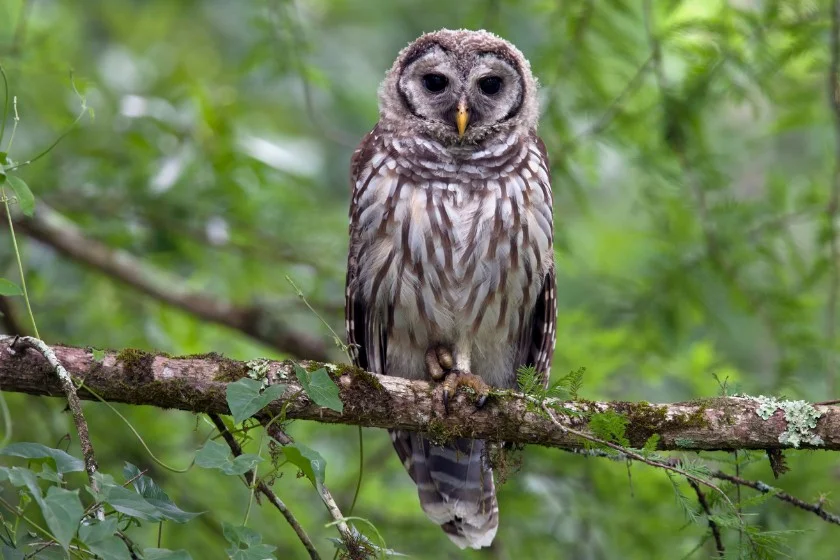
- Scientific name: Strix varia
- Length: 17 to 20 inches
- Weight: 16 to 37 pounds
- Wingspan: 39 to 43 inches
The barred owl is also called the northern barred owl or the striped owl, the latter being given because of its looks. It has a plethora of calls, each for a purpose.
Examples are cackling, screeching, and grumbling. This bird is one of the most common owl species in North America.
A peculiar trait of this creature is its drab color. It usually comes with brown or greyish-brown plumage.
These birds also live longer compared to other species. The longest recorded individual got up to 34 years!2
The barred owl is largely nocturnal, following the footsteps of other owls. It is active between sunset and dawn, which is when it hunts. The preferred diet includes small mammals, birds, and amphibians.
10. Northern Hawk Owl
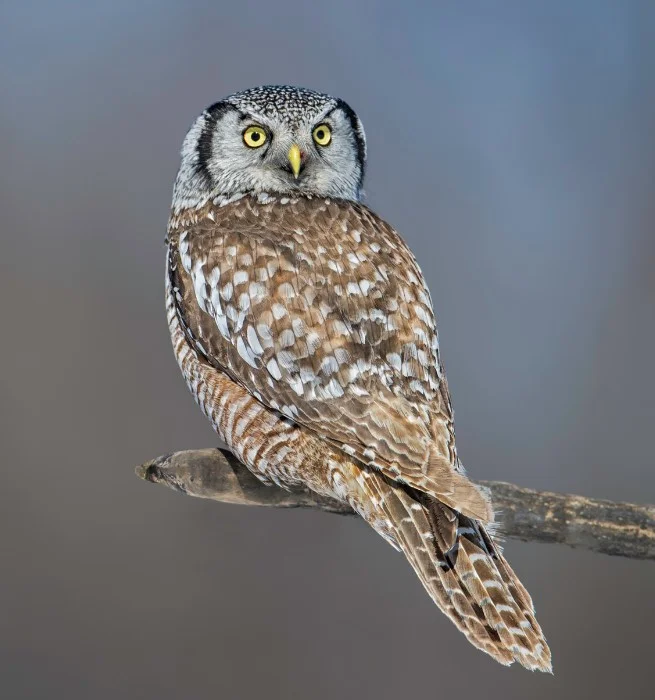
- Scientific name: Surnia ulula
- Length: 14 to 18 inches
- Weight: 8 to 16 pounds
- Wingspan: 28 inches
The northern hawk owl was given its name because it behaves like a hawk. It hunts by sight just like a hawk, looks like one, and is diurnal rather than nocturnal. It is rare in Michigan, but some have been seen in the northern region.
Its upper parts are colored a dark brown with white spots, while the lower parts are a creamy white with brown bars.
Its head is large and the forehead is shaped like a V. The face is dark, and the eyes are bright yellow.
The northern hawk owl nests in tree holes, especially when it needs to rest. It can also take over the stick nests of other birds. Preferred habitats include valleys, prairies, meadows, lakeshores, and pasturelands.
The bird makes a lot of calls, some sounding like ululululululul while others go more like a kip.
Because it is diurnal, it hunts during the daytime and rests at night. Its prey includes birds, rodents, and other small animals.
11. Boreal Owl
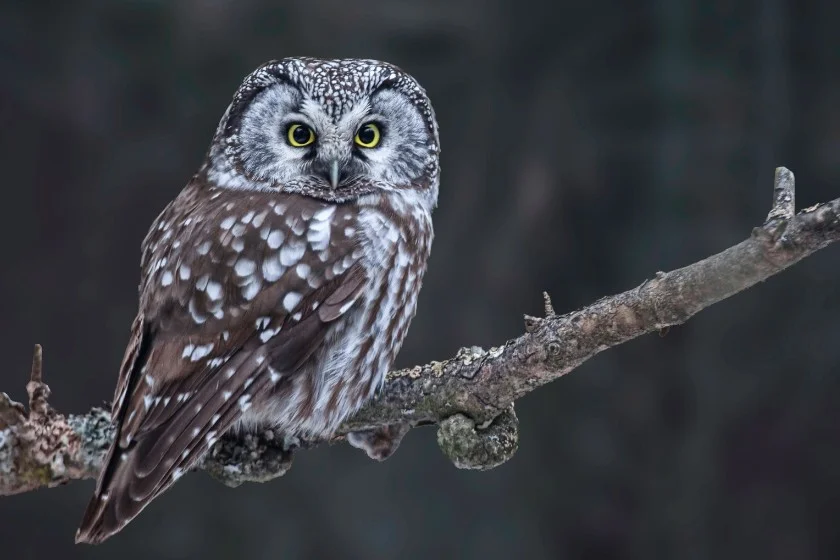
- Scientific name: Aegolius funereus
- Length: 8 to 11 inches
- Weight: 3 to 8 pounds
- Wingspan: 22 to 24 inches
The boreal owl is also known as the Tengmalm’s owl in Europe. It is a small, elusive bird that is hard to see as it tends to avoid contact.
This elusiveness serves to protect it from predators, but a lot of times, the boreal owl’s lifespan gets cut short because of these predators.
It isn’t just prey, however. The boreal owl is a predator as well, despite its size. It feeds on voles and other small mammals like mice, chipmunks, squirrels, etc.
One way to know you’ve seen a boreal owl is to look for a stunned expression. It also has brown feathers on its upper body and white lower parts that are streaked with brown. Additional traits are a large head, yellow eyes, and a greyish-white face.
How to Sight an Owl
Owling can sometimes be challenging, but it isn’t overly difficult. Here are some tips for owling:
- Learn all you need to know about the species in a particular area.
- Listen and observe. Sometimes an owl’s vocals give it away before you see it.
- If you do see one, don’t get too close or try startling it.
Conclusion
There are a total of eleven owls in Michigan, all of which we have explored. These birds have their habitats, behaviors, diet, and a variety of sounds.
Learning about animals can be fun, and we hope we’ve provided an invaluable resource on knowing the different owls that live in Michigan.
Next up…
References & Notes
- Northern Saw-Whet Owl. Owl Research Institute.
- Orfinger B. A., Helsel D., Breeding F. S. 2018. Longevity of the Barred Owl (Strix varia Barton, 1799) from captivity. The Wilson Journal of Ornithology.
